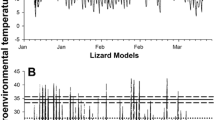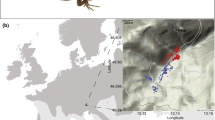Abstract
Viviparity (live-bearing) has evolved from oviparity (egg-laying) in more than 100 lineages of squamate reptiles (lizards and snakes). This transition generally has occurred in cool climates, where thermal differentials between eggs in the (cool) nest versus the (warm) maternal oviduct influence embryonic development, in ways that may enhance offspring fitness. To identify specific traits potentially under selection, we incubated eggs of a montane scincid lizard at conditions simulating natural nests, maternal body temperatures, and an intermediate stage (2-week uterine retention of eggs prior to laying). Incubation at maternal temperatures throughout incubation affected the hatchling lizard’s activity level and boldness, as well as its developmental rate, morphology, and locomotor ability. A treatment that mimicked the initial stages of the transition toward viviparity had a major effect on some hatchling traits (locomotor speeds), a minor effect on others (tail length, total incubation period) and no effect on yet others (offspring behaviors). More generally, different aspects of the phenotype are sensitive to incubation conditions at different stages of development; thus, the evolution of reptilian viviparity may have been driven by a succession of advantages that accrued at different stages of embryogenesis.




Similar content being viewed by others
References
Amiel JJ, Shine R (2012) Hotter nests produce smarter young lizards. Biol Lett 8:372–374
Bajer K, Horvátha G, Molnár O, Töröka J, Garamszegi LZ, Herczeg G (2015) European green lizard (Lacerta viridis) personalities: linking behavioural types to ecologically relevant traits at different ontogenetic stages. Behav Process 111:67–74
Bestion E, Teyssier A, Aubret F, Clobert J, Cote J (2014) Maternal exposure to predator scents: offspring phenotypic adjustment and dispersal. Proc R Soc B 281:20140701
Biro PA, Abrahams MV, Post JR, Parkinson EA (2004) Predators select against high growth rates and risk-taking behavior in domestic trout populations. Proc R Soc B 271:2233–2237
Blackburn DG (1985) Evolutionary origins of viviparity in the Reptilia. II. Serpentes, Amphisbaenia, and Ichthyosauria. Amphibia-Reptilia 5:259–291
Boon AK, Réale D, Boutin S (2007) The interaction between personality, offspring fitness and food abundance in North American red squirrels. Ecol Lett 10:1094–1104
Carazo P, Noble DWA, Chandrasoma D, Whiting MJ (2014) Sex and boldness explain individual differences in spatial learning in a lizard. Proc R Soc B 281:20133275
Careau V, Bininda-Emonds ORP, Thomas WD, Réale D, Humphries MM (2009) Exploration strategies map along fast-slow metabolic and life-history continua in muroid rodents. Funct Ecol 23:150–156
Cogger H (2014) The reptiles and amphibians of Australia. Reed Books, Sydney
Deeming DC (2004) Reptilian incubation: environment, evolution and behaviour. Nottingham University Press, Nottingham
Deeming DC, Ferguson MWJ (1988) Environmental regulation of sex determination in reptiles. Philos Trans R Soc B 322:19–39
Du W, Elphick M, Shine R (2010) Thermal regimes during incubation do not affect mean selected temperatures of hatchling lizards (Bassiana duperreyi, Scincidae). J Therm Biol 35:47–51
Elphick MJ, Shine R (1998) Long-term effects of incubation temperatures on the morphology and locomotor performance of hatchling lizards (Bassiana duperreyi, Scincidae). Biol J Linn Soc 63:429–447
Ghalambor CK, McKay JK, Carroll SP, Reznick DN (2007) Adaptive versus non-adaptive phenotypic plasticity and the potential for contemporary adaptation in new environments. Funct Ecol 21:394–407
Gilbert SF (2000) Developmental biology, 6th edn. Sinauer Associates, Sunderland
Griffith OW, Blackburn DG, Brandley MC, Van Dyke JU, Whittington CM, Thompson MB (2015) Ancestral state reconstructions require biological evidence to test evolutionary hypotheses: a case study examining the evolution of reproductive mode in squamate reptiles. J Exp Zool B 324:493–503
Johnston IA (2006) Environment and plasticity of myogenesis in teleost fish. J Exp Biol 209:2249–2264
King B, Lee MSY (2015) Ancestral state reconstruction, rate heterogeneity, and the evolution of reptile viviparity. Syst Biol 64:532–544
Li H, Holleley CE, Elphick M, Georges A, Shine R (2016) The behavioural consequences of sex reversal in dragons. Proc R Soc B 283(1832):20160217
Li H, Qu YF, Hu RB, Ji X (2009) Evolution of viviparity in cold-climate lizards: testing the maternal manipulation hypothesis. Evol Ecol 23:777–790
Lourdais O, Shine R, Bonnet X, Guillon M, Naulleau G (2004) Climate affects offspring phenotypes in a viviparous snake. Oikos 104:551–560
Löwenborg K, Shine R, Hagman M (2011) Fitness disadvantages to disrupted embryogenesis impose selection against suboptimal nest-site choice by female grass snakes, Natrix natrix (Colubridae). J Evol Biol 24:177–183
Mazué GPF, Dechaume-Moncharmont F, Godina JJ (2015) Boldness—exploration behavioral syndrome: interfamily variability and repeatability of personality traits in the young of the convict cichlid (Amatitlania siquia). Behav Ecol 26:900–908
McEvoy J, While GM, Sinn DL, Carver S, Wapstra E (2015) Behavioural syndromes and structural and temporal consistency of behavioural traits in a social lizard. J Zool 296:58–66
Medel RG, Jimenez JE, Fox SF, Jaaksic FM (1988) Experimental evidence that high population frequencies of lizard tail autotomy indicate inefficient predation. Oikos 53:321–324
Nakagawa S (2004) A farewell to Bonferroni: the problems of low statistical power and publication bias. Behav Ecol 15:1044–1045
Neaves L, Wapstra E, Birch D, Girling JE, Joss JMP (2006) Embryonic gonadal and sexual organ development in a small viviparous skink, Niveoscincus ocellatus. J Exp Zool A 305:74–82
Patrick SC, Weimerskirch H (2015) Senescence rates and late adulthood reproductive success are strongly influenced by personality in a long-lived seabird. Proc R Soc B 22:20141649
Pincheira-Donoso D, Tregenza T, Witt MJ, Hodgson DJ (2013) The evolution of viviparity opens opportunities for lizard radiation but drives it into a climatic cul-de-sac. Global Ecol Biogeogr 22:857–867
Pyron RA, Burbrink FT (2014) Early origin of viviparity and multiple reversions to oviparity in squamate reptiles. Ecol Lett 17:13–21
Qualls CP, Andrews RM (1999) Cold climates and the evolution of viviparity in reptiles: cold incubation temperatures produce poor-quality offspring in the lizard, Sceloporus virgatus. Biol J Linn Soc 67:353–376
Qualls CP, Shine R (1996) Reconstructing ancestral reaction norms: an example using the evolution of reptilian viviparity. Funct Ecol 10:688–697
Radder RS, Shine R (2007) Sex-based hatching asynchrony in an oviparous lizard (Bassiana duperreyi, Scincidae). Austral Ecol 32:502–508
Radder RS, Elphick MJ, Warner DA, Pike DA, Shine R (2008) Reproductive modes in lizards: measuring fitness consequences of the duration of uterine retention of eggs. Funct Ecol 22:332–339
Rodríguez-Díaz T, González F, Ji X, Braña F (2010) Effects of incubation temperature on hatchling phenotypes in an oviparous lizard with prolonged egg retention: are the two main hypotheses on the evolution of viviparity compatible? Zoology 113:33–38
Scheiner SM (2014) The Baldwin effect: neglected and misunderstood. Am Nat 184:ii–iii
Schwager SJ (1984) Bonferroni sometimes loses. Am Stat 38:192–197
Shine R (1983) Reptilian viviparity in cold climates: testing the assumptions of an evolutionary hypothesis. Oecologia 57:397–405
Shine R (1995) A new hypothesis for the evolution of viviparity in reptiles. Am Nat 145:809–823
Shine R (2002) Reconstructing an adaptationist scenario: what selective forces favor the evolution of viviparity in montane reptiles? Am Nat 160:582–593
Shine R (2004) Seasonal shifts in nest temperature can modify the phenotypes of hatchling lizards, regardless of overall mean incubation temperature. Funct Ecol 18:43–49
Shine R, Elphick M (2001) The effect of short-term weather fluctuations on temperatures inside lizard nests, and on the phenotypic traits of hatchling lizards. Biol J Linn Soc 72:555–565
Shine R, Harlow P (1993) Maternal thermoregulation influences offspring viability in a viviparous lizard. Oecologia 96:122–127
Shine R, Harlow P (1996) Maternal manipulation of offspring phenotypes via nest-site selection in an oviparous lizard. Ecology 77:1808–1817
Shine R, Olsson M (2003) When to be born? Prolonged pregnancy or incubation enhances locomotor performance in neonatal lizards (Scincidae). J Evol Biol 16:823–832
Shine R, Warner DA, Radder R (2007) Windows of embryonic sexual lability in lizards with environmental sex determination. Ecology 88:1781–1788
Shine R, Barrott EG, Elphick M (2002) Some like it hot: effects of forest clearing on nest temperatures of montane reptiles. Ecology 83:2808–2815
Shine R, Elphick M, Barrott EG (2003) Sunny side up: lethally high, not low, temperatures may prevent oviparous reptiles from reproducing at high elevations. Biol J Linn Soc 78:325–334
Sih A, Bell A, Johnson JC (2004) Behavioural syndromes: an ecological and evolutionary overview. Trends Ecol Evol 19:372–378
Telemeco R, Radder RS, Baird TA, Shine R (2010) Thermal effects on reptile reproduction: adaptation and phenotypic plasticity in a montane lizard. Biol J Linn Soc 100:642–655
Warner DA, Andrews R (2002) Laboratory and field experiments identify sources of variation in phenotypes and survival of hatchling lizards. Biol J Linn Soc 76:105–124
Warner DA, Shine R (2011) Interactions among thermal parameters determine offspring sex under temperature-dependent sex determination. Proc R Soc B 278:256–265
Acknowledgments
We thank Gregory P. Brown, Yanfu Qu, Simon Ducatez, Jodie Gruber, Jacquie Herbert, Uditha Wijethunga, and Chalene Bezzina for their help in the laboratory, and Michael Thompson for incubator space. H.L. thanks the Jiangsu Overseas Research & Training Program for its support in the form of a University Prominent Young & Middle-Aged Teacher’s Fellowship. H.L. was funded by the National Natural Science Foundation of China (31400341 and 31670422) and RS by the Australian Research Council.
Author contribution statement
HL, MJE, and RS designed the experiments. HL and MJE collected data. HL and RS analyzed the data. RS and HL drafted the manuscript, and all authors contributed to revisions.
Author information
Authors and Affiliations
Corresponding author
Ethics declarations
Conflict of interest
The authors declare that they have no conflict of interest.
Statement of animal rights
All research was conducted under the approval of the University of Sydney Animal Ethics Committee (protocol 2014/637).
Additional information
Communicated by Mark A. Chappell.
Rights and permissions
About this article
Cite this article
Li, H., Elphick, M. & Shine, R. Potential targets for selection during the evolution of viviparity in cold-climate reptiles. Oecologia 183, 21–30 (2017). https://doi.org/10.1007/s00442-016-3752-9
Received:
Accepted:
Published:
Issue Date:
DOI: https://doi.org/10.1007/s00442-016-3752-9




